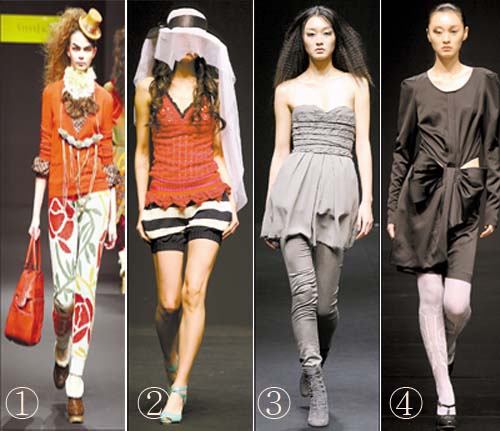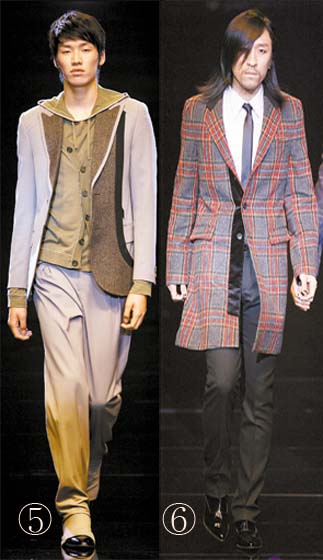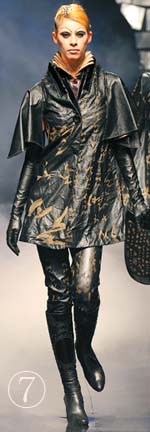Fashion needs a captain, not a boat full of pirates

So no one really understands the point of the game. The event reaches a dramatic zenith when some clever characters start playing mind games for personal gain. A few good guys struggle to make the game as sensible as possible. If the event were broadcast to the world and watched by professional players, they might find it mind-boggling.
The official face of Korean fashion, as represented by the Seoul Collections, has been precisely like this ever since the Korean government commissioned an agency ― formerly the Korea Fashion Association and now the Fashion Design Center ― to organize the country’s first international collections in 2000.
Almost two years after those Seoul Collections kicked off, a seasoned fashion businessman, Toh Shin-woo, started another government-backed fashion collection in the southern port city of Busan.

By size and budget, the Pret-a-Porter Busan fashion collections are much smaller than Seoul. At the Busan Exhibition and Convention Center, in the Haeundae district of Busan, the 2007 fall and winter collections featured just 11 designers from Korea and overseas, from April 12 to 14. Over the three days the event attracted about 150,000 spectators. They come from Busan and “all over the south of Korea to see rare fashion shows by Korea’s celebrity designers,” said the organizer. Also invited were 80 reporters from the Korean media and 30 from France and Canada.
This is the first time that Busan’s collections have been shown in April, and it has taken Toh nearly five years to make Busan’s fashion event fit properly into the calendar.
In Busan, the objectives of the fashion collections are made clear by Toh, a tall and slim man who started his career as a fashion model back in the 1970s and then founded a leading model agency in the 1980s. It’s apparent he understands the mechanics of the Korean fashion industry, its unique history and current position in the world.
The Paris-based journalist Francois Guenet, who attended this year’s Seoul Collections, said the Busan fashion shows may be smaller but had better quality and preparation.
Toh, who is based in Seoul, justified the existence of the Busan show with a reference to the city’s plans to promote its image. The same strategy lies behind its famous international film festival.
“Busan was made so famous by the film festival,” Toh said. “And with regular fashion collections, the image can only improve. When Busan designers demanded the presence of foreign buyers, I advised them to attend international trade shows and build their reputation and learn about the international business first. They must realize that buyers will not just fly out to Busan at a random time in the international fashion calendar.”

So how does Pret-a-Porter Busan work? After each season, Toh and his team in Seoul select designers for the next collection. All costs are paid by the organizer, who works within the city’s budget of 300 million won ($280,000) plus sponsorship by local companies. Asian designers come mostly from Korea, Japan and China. “It is too early for Korean fashion to compete globally,” he said, “It is more realistic and logical to establish a name first in Asia.”
In an attempt to collaborate with Asian partners, Toh includes one designer each from Japan and China: In this season’s show it was Chiyuki from Japan and Mary Ma from Shanghai.
Organizing large-scale fashion shows in Busan has always created dilemmas for the organizers. They need to include designers from the local market, so there are two native designers from Busan, who target middle-aged women in the region.
But to raise the glamour quotient and attract journalists, they need to show work by rising stars from the fashion capitals of the world. This year, Christian Wijants, Gaspard Yurkievich and the team of Steve J and Yoni P demonstrated what it takes to be successful in Antwerp, Paris and London, respectively.
or European designers, being in Busan is strictly about business opportunities, as they venture into the growing Korean market. Yurkievich, who has a line of shoes with a Korean company, finds the invitation “a great opportunity” and spends additional days in Seoul to better understand the Korean fashion market.
It is these non-global powerhouse designers who have gradually nurtured the local fashion market, where the concept of “buyers” working for department stores is still new. Also Korean buyers, who would not normally travel to Europe, can set up meetings with the designers.
Wijants showed one season last year and has since been selling his clothes in three upscale boutiques in Seoul. Even if he sells only a small number of items here, the Paris-based designer, who retails his clothes through 50 stores worldwide, believes in the future of individual designers in global markets.
For Korean designers like Lie Sang-bong and Chang Kwang-hyo, who sell their clothes in Busan department stores, fashion shows in the city are a form of customer service ― like a rock star making a rare appearance in his hometown.
During Pret-a-Porter Busan fashion delirium swept the crowd ― which constantly raved about how good-looking the Korean models were ― when men and women emerged from smoky dry ice and performed for the catwalk glitterati in gaudy leather outfits emblazoned with Korean writing.
When the organizers announced via the Internet that the popular men’s wear designer Choi Bum-suk, who rarely appears outside Seoul, would show up in Busan, over 100,000 fans visited the collections’ official Web site, causing it to temporarily shut down.
Korean fashion fever aside, Chang Kwang-hyo grew emotional while speaking about life as a Korean designer. “Over many rocky years, I’m truly grateful and fortunate that I was able to carry on my career,” he said. “But how long do Korean designers have to go on holding such expensive fashion shows that seem to give us nothing in return?”
Chang pointed out that the currently confused state of the Korean fashion industry makes it much tougher for young designers to pursue their careers. “I feel hopeless when I see talented designers who cannot stand the hard life of being an assistant drop out because they cannot see their future here,” he said. “It’s either they quit or they go abroad and compete among real professionals ― like the young Korean designers, Steve J & Yoni P, who are based in London.”
Chang stressed that fashion designers must continue with their shows in order to stay sharp. “This is the time to be truly original in design and concept with a strong personal identity,” he said.
The nature of fashion events is similar to that of sports tournaments. Players must be exceptional. Critics must understand the dynamics of the players and the games they play. And sponsors and supporters alike should trust the players.
If Korean fashion wants more or less the same success as its soccer team achieved at the 2002 World Cup, the industry must follow a similar path. It requires a step-by-step investment in a few globally proven talents who can guarantee performance with winning strategies provided by a world-class coach ― the way that Dutch captain Gus Hiddink led South Korea to many victories.
When everyone, from critics to reporters to fans, understand how the game works, inside and out, then fashion will have a future that truly works.
①Steve J & Yoni P
The rising stars from the London Collections presented a refreshingly quirky and original mixture of Tibet-meets-British funk and tailoring ― although the tailoring was sometimes too fussy.
②Chiyuki
The Tokyo-based designer Chiyuki Sugimoto demonstrated his strength in carefully crafted knit-wear and feminine dresses inspired by beauty, innocence and the light colors seen in the summer ocean.
③Christian Wijants
The Paris-based Belgian designer was inspired by muted colors, marble and the symbolism found in Belgian art and architecture from the early 20th century, including images from medieval cities such as Brugge and Ghent.
④Gaspard Yurkievich
From elegantly draped dresses and capes to sporty sneakers and jersey tops for clubbers, the Paris-based designer lives for the contemporary consumer. Everyone noticed his extra-large weekend bags.
⑤Chang Kwang-hyo
Looking back over his 25-year career in fashion, the Korean designer went back to his youth while looking into the future. The overall look is streamlined and soft, but not feminine, with mix-and-match details that sparkled.
⑥Choi Bum-suk
Inspired by images from Guy Richie’s 1998 film “Lock Stock And Two Smoking Barrels,” the Korean designer’s style employed a vintage British look that’s half glamorous (tailored jackets) and half street-style (trendy Y-shaped pants).
⑦Lie Sang-bong
The show opened with this designer’s famous flirtation with Hangeul and fusion dance music. His attempt to incorporate Korean elements was well-received, but critics remain divided over his overall approach.
By Ines cho Staff Writer [inescho@joongang.co.kr]










with the Korea JoongAng Daily
To write comments, please log in to one of the accounts.
Standards Board Policy (0/250자)